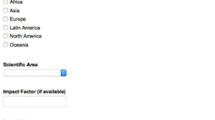Abstract
This paper presents the journal relative impact (JRI), an indicator for scientific evaluation of journals. The JRI considers in its calculation the different culture of citations presented by the Web of Science subject categories. The JRI is calculated considering a variable citation window. This citation window is defined taking into account the time required by each subject category for the maturation of citations. The type of document considered in each subject category depends on its outputs in relation to the citations. The scientific performance of each journal in relation to each subject category that it belongs to is considered allowing the comparison of the scientific performance of journals from different fields. The results obtained show that the JRI can be used for the assessment of the scientific performance of a given journal and that the SJR and SNIP should be used to complement the information provided by the JRI. The JRI presents good features as stability over time and predictability.




Similar content being viewed by others
References
Bergstrom, C. (2007). Eigenfactor: Measuring the value and prestige of scholarly journals. C&RL News, 68(5), 314–316.
Bollen, J., Rodriguez, M. A., & Van De Sompel, H. (2006). Journal status. Scientometrics, 69(3), 669–687.
Bollen, J., & van de Sompel, H. (2008). Usage impact factor: The effects of sample characteristics on usage-based impact metrics. Journal of the American Society for Information Science and Technology, 59(1), 136–149. doi:10.1002/asi.20746.
Garfield, E., & Sher, I. H. (1963). New factors in evaluation of scientific literature through citation indexing. American Documentation, 14(3), 195.
Gavel, Y., & Iselid, L. (2008). Web of Science and Scopus: A journal title overlap study. Online Information Review, 32(1), 8–21. doi:10.1108/14684520810865958.
Glanzel, W., & Schoepflin, U. (1995). A bibliometric study on aging and reception processes of scientific literature. Journal of Information Science, 21(1), 37–53.
Gonzalez-Pereira, B., Guerrero-Bote, V. P., & Moya-Anegon, F. (2010). A new approach to the metric of journals’ scientific prestige: The SJR indicator. Journal of Informetrics, 4(3), 379–391. doi:10.1016/j.joi.2010.03.002.
Jacso, P. (2005). As we may search–comparison of major features of the Web of Science, Scopus, and Google scholar citation-based and citation-enhanced databases. Current Science, 89(9), 1537–1547.
Kyvik, S. (2003). Changing trends in publishing behaviour among university faculty, 1980–2000. Scientometrics, 58(1), 35–48.
Leydesdorff, L. (2007). Betweenness centrality as an indicator of the interdisciplinarity of scientific journals. Journal of the American Society for Information Science and Technology, 58(9), 1303–1319. doi:10.1002/asi.20614.
Lisee, C., Lariviere, V., & Archambault, E. (2008). Conference proceedings as a source of scientific information: A bibliometric analysis. Journal of the American Society for Information Science and Technology, 59(11), 1776–1784. doi:10.1002/asi.20888.
Lloyd, E. (1984).Handbook of applicable mathematics vol. VI, Part B. Statistics (1st ed.). New York: John Wiley & Sons.
Lopez-Illescas, C., de Moya-Anegon, F., & Moed, H. F. (2008). Coverage and citation impact of oncological journals in the Web of Science and Scopus. Journal of Informetrics, 2(4), 304–316. doi:10.1016/j.joi.2008.08.001.
Moed, H. F. (2010). Measuring contextual citation impact of scientific journals. Journal of Informetrics, 4(3), 265–277. doi:10.1016/j.joi.2010.01.002.
Moed, H. F., Van Leeuwen, T. N., & Reedijk, J. (1998). A new classification system to describe the ageing of scientific journals and their impact factors. Journal of Documentation, 54(4), 387–419.
Moed, H. F., & Visser, M. S. (2007). Developing bibliometric indicators of research performance in computer science: An exploratory study. Research Report to the Council for Physical Sciences of the Netherlands Organisation for Scientific Research. Hague: Netherlands Organisation for Scientific Research.
Murugesan, P., & Moravcsik, M. J. (1978). Variation of nature of citation measures with journals and scientific specialties. Journal of the American Society for Information Science, 29(3), 141–147.
Nederhof, A. J. (2005). Bibliometric monitoring of research performance in the social sciences and the humanities: A review. Scientometrics, 66(1), 81–100. doi:10.1007/s11192-006-0007-2.
Opthof, T., & Leydesdorff, L. (2010). Caveats for the journal and field normalizations in the cwts (“leiden”) evaluations of research performance. Journal of Informetrics, 4(3), 423–430.
Pinski, G., & Narin, F. (1976). Citation influence for journal aggregates of scientific publications–theory, with application to literature of physics. Information Processing & Management, 12(5), 297–312.
Shepherd, P. T. (2010). The feasibility of developing and implementing journal usage factors: A research project sponsored by UKSG. The Journal of Serials Community, 20, 117–123.
Small, H., & Sweeney, E. (1985). Clustering the science citation index using co-citations. 1. A comparison of methods. Scientometrics, 7(3–6), 391–409.
Sombatsompop, N., Markpin, T., Yochai, W., & Saechiew, M. (2005). An evaluation of research performance for different subject categories using impact factor point average (IFPA) index: Thailand case study. Scientometrics, 65(3), 293–305. doi:10.1007/s11192-005-0275-2.
Van Leeuwen, T. N., & Moed, H. F. (2002). Development and application of journal impact measures in the Dutch science system. Scientometrics, 53(2), 249–266.
Vieira, E. S., & Gomes, J. A. N. F. (2010). Citations to scientific articles: Its distribution and dependence on the article features. Journal of Informetrics, 4(1), 1–13. doi:10.1016/j.joi.2009.06.002.
Zitt, M., & Small, H. (2008). Modifying the journal impact factor by fractional citation weighting: The audience factor. Journal of the American Society for Information Science and Technology, 59(11), 1856–1860. doi:10.1002/asi.20880.
Author information
Authors and Affiliations
Corresponding author
Rights and permissions
About this article
Cite this article
Vieira, E.S., Gomes, J.A.N.F. The journal relative impact: an indicator for journal assessment. Scientometrics 89, 631–651 (2011). https://doi.org/10.1007/s11192-011-0469-8
Received:
Published:
Issue Date:
DOI: https://doi.org/10.1007/s11192-011-0469-8




